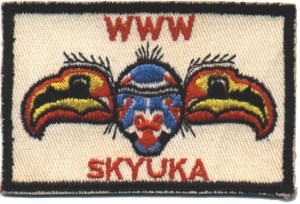The Legend of the Double Headed Thunderbird of Skyuka 270
During the first few years of Skyuka Lodge there were no volunteer advisors. Franklin Chase, a Field Scout Executive, was selected to be the professional advisor and he remained in that position for several years before the first Lodge Advisor or Chief. Finally, upon mutual agreement by the lodge and the Palmetto Council Camping Committee, Bill Huskey became the first lay volunteer advisor. He had been in the Order of the Arrow and had knowledge of the duties of such a person.
During these years the lodge grew in numbers and the first brotherhood and Vigil Honor members were inducted into the lodge. The lodge was then able to accept full responsibility for its actions such as ceremonies, induction of new members, the business parts of the lodge, and finally the keeping and maintaining of lodge records.
The Lodge decided it had to have its own "patch.” A committee within the organization was formed to develop an emblem. The first lodge patch was a green triangle with an outline of Skyuka Mountain on it. After a while, the Brotherhood members wanted a patch of their own or at least a special Brotherhood patch of some sort.
The patch design was the headpiece of the fire ceremonial totem pole of the Kwaticut Indians of British Columbia and Alaska. The lodge advisor had seen this totem pole while serving with the Canadian Army and recommended it to the lodge. It was so colorful that all members accepted it. We know this totem pole design as our own double-headed thunderbird.
Submitted by Lode Editor Richard Cash
Please Leave Comments Below!
I always wondered. This makes a lot more sense now…
“The illustrated masks originated in the villages of many of the 30 some Kwakwala speaking tribes described by Boas as the “Kwakiutl” (now refered to as the Kwakwaka’wakw).”
http://www.firstnations.eu/img/04-2-2-masks-2.jpg
http://www.firstnations.eu/fisheries/kwakwakawakw-kwakiutl.htm




Thank you for sharing this information, Richard. I always wondered about the rectangular Brotherhood patch. My father, Cliff Jones, became a Scoutmaster in 1945, just after 270 formed. Frank Chase was Scout Executive for our area, and my Dad thought the world of Mr. Chase! I wasn’t around in 1945, but in the early 60’s, Mr. Chase, who had moved on to other councils, did come to visit us. Very nice fellow!